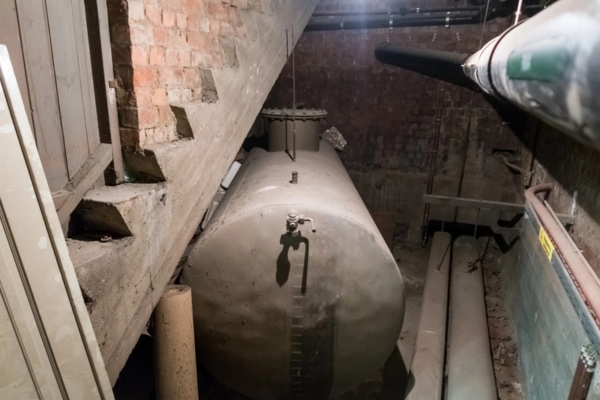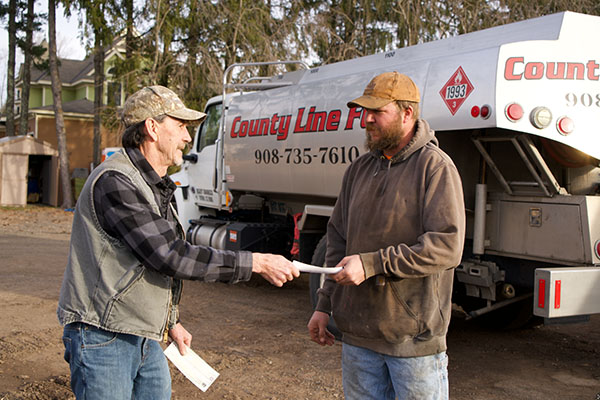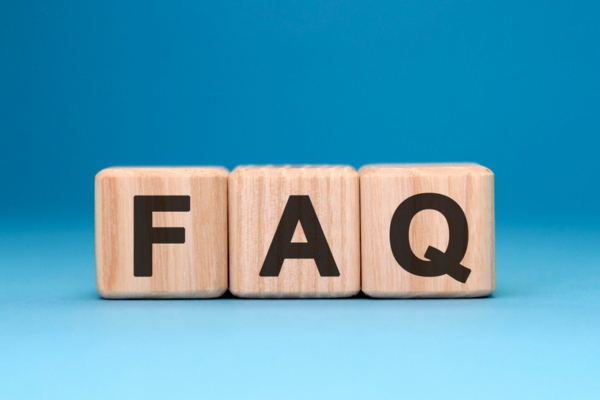Table of Contents
Water in oil tank can cause serious damage and impact the efficiency of your heating system. At County Line Fuel, your reliable heating oil provider in Clinton, NJ, we help homeowners understand the causes of water in oil tanks and offer solutions to protect their heating systems from potential harm.
This article explores the typical causes of water contamination in oil tanks, including condensation and external leaks. It also outlines practical measures to maintain fuel quality and avoid expensive damage. Following the proper precautions can keep your system clean and operating efficiently year-round.
Ensure Consistent Heating Oil Delivery: Keep your tank full and water-free. Contact County Line Fuel today!
Water in Oil Tank: What Causes It?

Water in your oil tank can originate from several sources, and understanding these causes is essential for preventing damage. This section will examine how water enters your tank and the steps you can take to address these issues effectively.
Safeguard Your System with Professional Oil Tank Services: Whether it’s inspections or installations, we’re here to help. Reach out to us today!
Condensation Inside Your Heating Oil Tank
Condensation forms inside a heating oil tank when warm indoor air meets the cold surface of the tank, causing moisture to accumulate. This is more likely to happen when there is a large temperature difference between the indoor air and the tank.
Moreover, excess humidity in the space above the oil creates a pocket of moist air, which encourages ongoing condensation, leading to increased moisture buildup over time.
Inadequate ventilation around the tank can worsen the issue by trapping moisture-rich air against the tank’s walls. This prevents the moisture from escaping, allowing condensation to persist. Over time, this internal moisture accumulation can contaminate heating oil and reduce system efficiency.
Damaged Oil Storage Tank: Issues with Filler and Vent Caps

A faulty or missing filler cap seal or vent caps can cause moisture contamination in your fuel oil storage tank. Worn gaskets around the filler opening allow rainwater and snowmelt to seep in, introducing external moisture to the tank.
Additionally, improperly seated or missing vent caps on the breathing vents and fill ports increase the risk of moisture infiltration. These gaps in the tank’s seals let humid air and water enter, contributing to contamination.
Clogged or corroded zinc flappers can no longer prevent moisture from entering the tank, weakening its structure and causing lasting damage. To avoid moisture-related problems, it’s vital to conduct regular inspections of the oil tank breathers and seals.
Upgrade to a Long-Lasting Oil Storage Tank: Replace your old unit with a top-quality model. Contact County Line Fuel today!
Structural Cracks and Weld Failures in Heating Oil Tanks
Corrosion is a leading cause of structural damage in heating oil tanks. Rust that forms beneath the paint or insulation can create pinholes and cracks, enabling moisture to enter the tank and contaminate the fuel. Another critical issue is weld seam failure. Over time, stress points at factory seams or repair welds become susceptible to cracking, resulting in leaks and further damage.
Additionally, mechanical damage from accidental impacts or shifting foundations can lead to fractures in the tank walls. These structural issues, including corrosion cracks and weld seam leaks, weaken the tank’s integrity, potentially causing costly repairs and fuel contamination.
External Water Infiltration into Fuel Oil Tanks

External water can infiltrate a fuel oil tank in various ways, contaminating fuel. Flooding in basements or heavy rain can surround the tank, causing contaminated floodwater to seep into the oil through damaged seals or gaps.
For tanks buried underground, rising groundwater can penetrate unsealed tank walls, resulting in significant contamination. Poor drainage around the tank, caused by improper grading or a lack of proper gutters, can worsen this situation by allowing water to accumulate near the tank. This raises the likelihood of leaks and moisture infiltration. Ensuring proper drainage around the tank is crucial to prevent water from entering and impacting the fuel’s quality.
Avoid Disruptions with Regular Oil Deliveries: Keep your tank full and moisture-free throughout the season. Contact us now!
Environmental and Site Factors

Environmental and site conditions are crucial in water infiltration into oil tanks. High-humidity areas, such as coastal or tropical climates, increase moisture exposure to the tanks, resulting in higher condensation levels. Additionally, tanks located near humidity-prone areas within the home, such as laundry rooms or bathrooms, experience elevated indoor moisture, which can significantly contribute to water buildup inside the tank.
Seasonal temperature fluctuations further increase the likelihood of condensation, as rapid shifts between hot and cold air cause moisture in the environment to condense on the tank’s surfaces. By understanding the climate-related moisture factors affecting oil tanks and identifying sources of indoor humidity, homeowners can take proactive measures to prevent internal moisture accumulation and protect their fuel quality.
Stay Comfortable with Reliable Oil Deliveries: Schedule your next heating oil delivery today. Contact County Line Fuel now!
Consequences of Water Contamination in a Home Oil Tank

Water contamination in an oil tank can cause many serious problems, affecting the tank and the heating system. Here are the main consequences:
- Microbial Growth & Sludge: Water accumulation at the bottom of the tank creates an ideal environment for microbial growth, especially the “diesel bug.” These microorganisms thrive in the water, leading to fuel contamination and sludge buildup. The resulting sludge can clog filters and hinder fuel flow.
- Heating Oil Tank Corrosion and Pitting: Trapped moisture accelerates rusting inside the tank, causing corrosion and pitting of the tank walls. This process weakens the tank’s structure, making it more susceptible to leaks and reducing its reliability, ultimately compromising the heating system’s efficiency.
- Oil-Heat Equipment Performance Issues: Water contamination in the oil tank can result in clogged filters, burner misfires, and decreased heating efficiency. These problems reduce the overall performance of the heating system, leading to more frequent repairs and higher maintenance costs. Such contamination effects can significantly disrupt home heating.
Complete Oil Tank Replacement Services: Rely on County Line Fuel for smooth installations and ultimate peace of mind. Contact us today!
Preventive Measures and Professional Care

Proactive care for your oil tank is essential to preventing water contamination and extending the life of your heating system. The following practices can help you avoid costly issues while keeping your tank performing at its best:
- Maintain Proper Heating Oil Fill Levels: Keep the tank filled to at least 80% of its capacity to reduce headspace moisture and lower the chance of condensation. This limits the amount of air that can enter the tank, which otherwise may carry moisture.
- Install Quality Breather and Filter Systems: Use desiccant breathers and water-separating filters on the fill and fuel lines to block moisture before it can enter the tank. These components effectively prevent water ingress, ensuring the fuel remains clean.
- Routine Oil Tank Inspections: Schedule regular professional inspections to check seals, vents, and the tank’s structural condition. Identifying and addressing potential problems early helps prevent contamination and structural damage.
Ensure Fuel Quality All Year Long: Pair your heating oil delivery with expert tank inspections. Reach out to us today!
Water in Oil Tank: FAQs

How Can I Identify Water in a Buried Oil Tank?
Professional technicians use advanced tools, such as water-finding paste on dipsticks and electronic moisture probes, to locate water layers at the bottom of the tank. These techniques allow for accurate water accumulation detection without digging up the tank, helping prevent contamination from reaching your burner.
Does Water in My Oil Tank Pose a Risk to My Heating Equipment?
Yes, water in your oil tank can cause significant damage. Even small amounts can lead to microbial growth, commonly known as the “diesel bug,” which creates sludge that clogs filters and injectors. Additionally, water can corrode pump seals and nozzle assemblies, resulting in misfires, inefficient combustion, and costly repairs or equipment failure if not addressed promptly.
How Can I Detect Fuel Contamination from Water in My Tank?
Watch for these signs:
- Cloudy or Layered Fuel Samples: When extracting a sample, visible water or sediment layers may appear, indicating contamination.
- Frequent Filter Clogs: If filters clog quickly, even when new, it may point to water-related debris or microbial sludge in the system.
- Sooty or Discolored Flame: Water in the fuel can affect combustion, resulting in a sooty or yellow-tinged flame and smoky exhaust.
- Inconsistent Burner Cycling: If your burner is cycling irregularly, with short runs or hard starts, it could mean water is disrupting smooth fuel delivery.
Avoid Expensive Issues: Replace corroded tanks before they cause damage. Schedule your oil tank replacement with County Line Fuel today!
How Can I Improve My Tank’s Resistance to Moisture?
- Maintain High Fill Levels: Keep your tank filled to at least 80–90% to reduce the headspace where humid air can condense.
- Enhance Ventilation & Insulation: Install exhaust fans or dehumidifiers in the tank area, and consider using tank jackets or foam insulation to minimize temperature fluctuations.
- Install Desiccant Breathers & Water-Blocking Filters: These devices help capture moisture before it can enter the tank or fuel line.
- Use Fuel Additives: Follow manufacturer guidelines for adding anti-condensation and biocide additives. These help bind free water and prevent microbial growth, working alongside physical moisture controls for added protection.
Are Newer Oil Tank Designs Less Susceptible to Water Intrusion Than Older Models?
Yes. Newer oil tanks are designed with seamless, factory-welded construction, internal corrosion-resistant coatings, and advanced vent-cap systems with built-in moisture barriers. These improvements help minimize seepage and condensation, offering better protection against water intrusion compared to older steel or uncoated tanks, greatly reducing the risk of water entering the tank.
Conclusion
Water can infiltrate your oil tank through condensation, damaged caps, structural issues, and inadequate site conditions. These problems contribute to heating oil contamination and reduced system performance, making prevention essential for ensuring the reliability of your heating system. Regular maintenance and inspections are vital to avoid costly repairs and keep your oil tank in optimal condition.
Worried about water in your oil tank? Contact County Line Fuel in Clinton, NJ today for a thorough oil tank inspection, expert heating oil care, and dependable solutions. Rely on our local oil tank professionals to safeguard your heating system and maintain smooth operation.
Rely on County Line Fuel, Your Local Heating Oil Experts: Schedule your next oil delivery today for hassle-free warmth. Contact us now!
Contact County Line Fuel for Reliable Heating Oil Delivery Services

County Line Fuel is committed to keeping homes and businesses throughout Clinton, NJ warm and comfortable with our dependable heating oil delivery services. We focus on delivering high-quality heating oil efficiently, ensuring you get the warmth you need without any hassle. Our dedication to top-tier service means we offer competitive rates and transparent, straightforward solutions that always prioritize your comfort.
We provide a variety of heating oil delivery plans and financing options so that you can tailor your fuel delivery to your specific needs. Each customer receives personalized service, ensuring their home stays warm and comfortable throughout the winter season.
Beyond heating oil delivery, County Line Fuel offers comprehensive HVAC services, making us your one-stop solution for all home comfort needs. From installation and maintenance to emergency repairs, we cover all aspects of HVAC care.
Choosing County Line Fuel means working with a trusted, dependable provider. With a reputation for reliable service and a strong commitment to customer satisfaction, County Line Fuel is a trusted name in the community. Contact us today to get started!
You can click here to contact us now or call us at (908) 735-7610 to find out more! Click the link to view our service area.
Related Articles:
